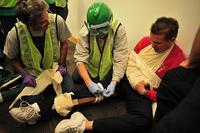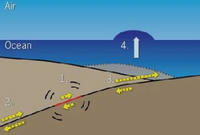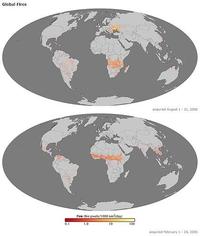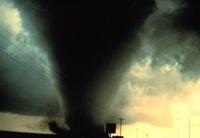-
U.S. cities preparing for disasters

In the last year the United States, among other challenges, faced Hurricane Sandy, the Sandy Hook shooting, the Boston Marathon bombings, and Tornadoes in Oklahoma. The future is unpredictable, so cites across the United States are taking steps to be in a better position to respond to disasters.
-
-
Identifying regions with multiple forest threat potential, including wildfires
A recent study offers emergency managers a tool to help them identify regions exposed to multiple forest threats. The tool uses a novel 15-mile radius neighborhood analysis to highlight locations where threats are more concentrated relative to other areas, and identifies where multiple threats may intersect. It is a technique that may have never been used before to describe forest threats, according to the researchers.
-
-
Insurers face minimum $4 billion payout from May U.S. storm damage
Total economic losses from the Oklahoma tornado – in fact, the event comprised at least sixty-one confirmed tornado touchdowns — are preliminarily estimated at $5.0 billion, amid insured losses of at least $2.5 billion. Total economic losses from flash flooding in the Plains and Midwest, and from damaging winds in the Northeast, are expected to exceed $2.0 billion, with insured losses above $1.0 billion.
-
-
Earthquake acoustics can indicate a massive tsunami is coming

Although various systems can detect undersea earthquakes, they cannot reliably tell which will form a tsunami, or predict the size of the wave. There are ocean-based devices that can sense an oncoming tsunami, but they typically provide only a few minutes of advance warning. Scientists have now identified key acoustic characteristics of the 2011 Japan earthquake that indicated it would cause a large tsunami. The technique could be applied worldwide to create an early warning system for massive tsunamis.
-
-
U.S. hurricane supercomputers need an upgrade
During the hurricane season, which began last week, the U.S. National Weather Service (NWS) will use models from several supercomputers from around the world to generate predictions about hurricanes’ landfall, path, and intensity. Meteorologists say that the two American supercomputers used for storm modeling are underpowered and inferior to European computers.
-
-
Flames change the sound of a firefighters' personal safety alarm
The PASS, short for Personal Alert Safety System, has been used by firefighters for thirty years to help track members of their team who might be injured and need assistance to escape a fire. Though the alarm has saved many lives, there are cases in which the device is working correctly but is not heard or not recognized.
-
-
Wildfires in west, southwest forcing hundreds from their homes
The arrival of summer has typically been accompanied by an increase in the number and intensity of wild fires in the U.S. southwest, and this year is no exception.
-
-
Mitigating fires in the wildland-urban interface

More than forty-six million residential structures in about 70,000 communities in the United States are located in the so-called wildland-urban interface (WUI). On average, WUI fires destroy 3,000 buildings annually. They accounted for six of the ten most costly fires in the United States over the last 100 years. Five of these fires occurred in California, where the incidence of wildfires currently is up 47 percent this year over last.
-
-
Relying on natural gas-fired generators during electric grid failures
Natural gas-fired electricity generators can provide energy security at domestic military installations in the event of electric grid failures. A study found there is minimal risk of interrupted deliveries for a moderate outage (two weeks to three months).
-
-
Crowdfunding disaster relief gaining in popularity
A new way to raise funds for disaster victims is gaining in popularity. It is called crowdfunding. The majority of crowdfunding Web sites take a 3 percent to 8 percent cut of the money that is raised — far less than the 25 percent cut most large charities take.
-
-
Firefighters, FAA weighing the use of drones for wildfires
With the wildfire season already claiming land and homes in the Western United States, federal government firefighters are considering the use of drones outfitted with cameras to map out the size and speed of a wildfire.
-
-
As wildfires increase, scientists call for more study of terrestrial, atmospheric effects

Wildfire is a disturbance of ecosystems, and concerns continue to grow about the terrestrial and atmospheric effects of wildfires. Wildfires are expected to increase 50 percent across the United States under a changing climate, over 100 percent in areas of the West by 2050 as projected by some studies.
-
-
A majority on Earth will soon face severe, self-inflicted water shortage: scientists

A conference of 500 leading water scientists from around the world, held last week in Bonn, issued a stark warning that, without major reforms, “in the short span of one or two generations, the majority of the nine billion people on Earth will be living under the handicap of severe pressure on fresh water, an absolutely essential natural resource for which there is no substitute. This handicap will be self-inflicted and is, we believe, entirely avoidable.”
-
-
New technologies help in tornado prediction

Scientists are working to increase tornado warning times. A new method, known as “warn-on forecasts,” will issue warnings based on forecasts rather than on observations. These warnings could increase the warning time to one -to-six hours before a tornado touches down. Another methodology being developed would give meteorologists the ability to tell people how strong the tornado will be before it hits the ground.
-
-
Understanding slow earthquakes helps in earthquake prediction
Earthquakes that last minutes rather than seconds are a relatively recent discovery, according to an international team of seismologists. Researchers have been aware of these slow earthquakes only for the past five to ten years because of new tools and new observations, but these tools may explain the triggering of some normal earthquakes and could help in earthquake prediction.
-
More headlines
The long view
The Surprising Reasons Floods and Other Disasters Are Deadlier at Night
It’s not just that it’s dark and people are asleep. Urban sprawl, confirmation bias, and other factors can play a role.
Why Flash Flood Warnings Will Continue to Go Unheeded
Experts say local education and community support are key to conveying risk.
